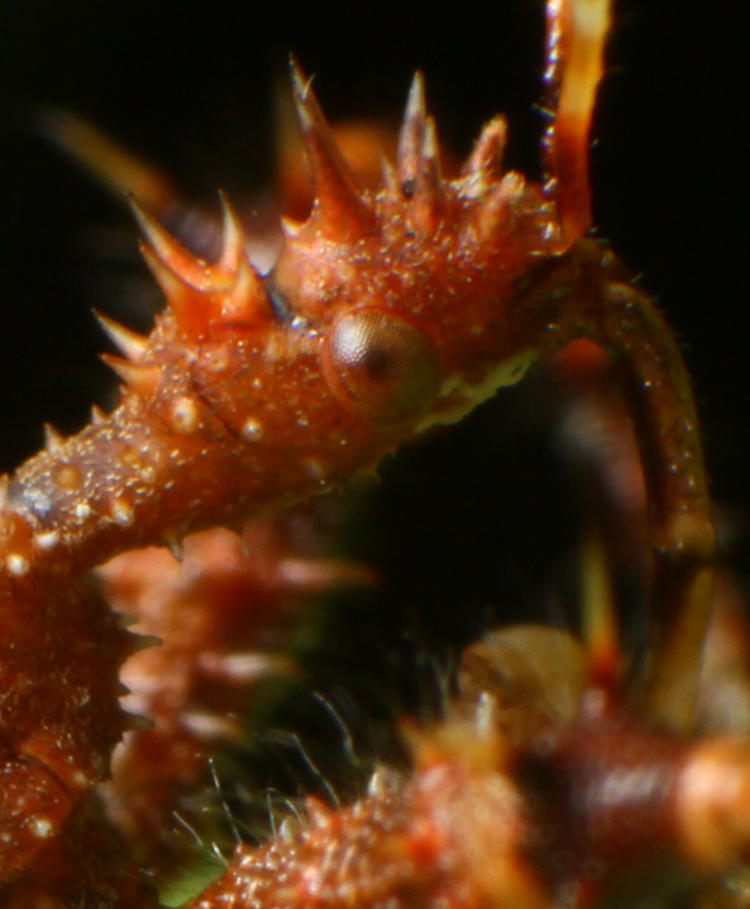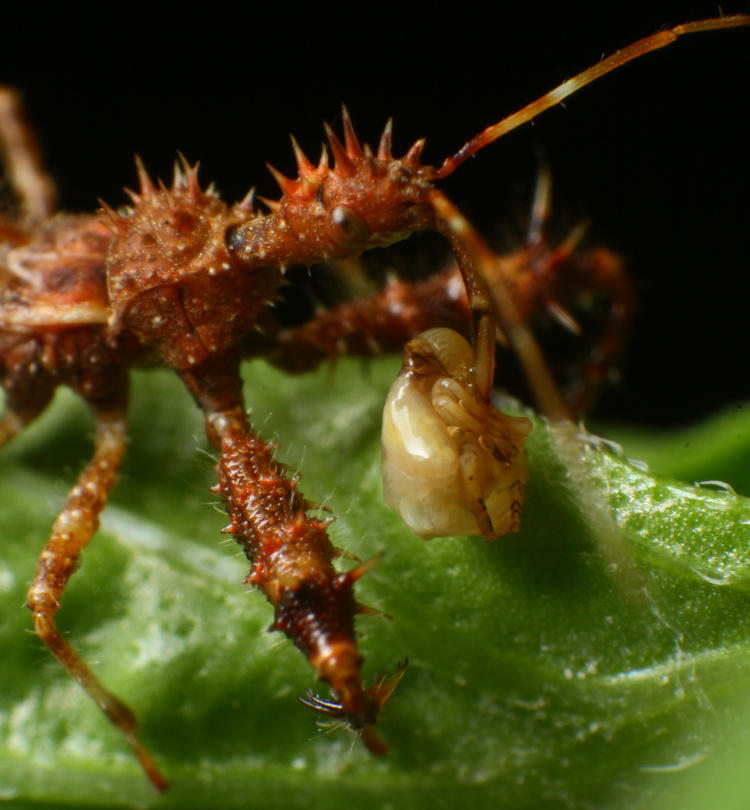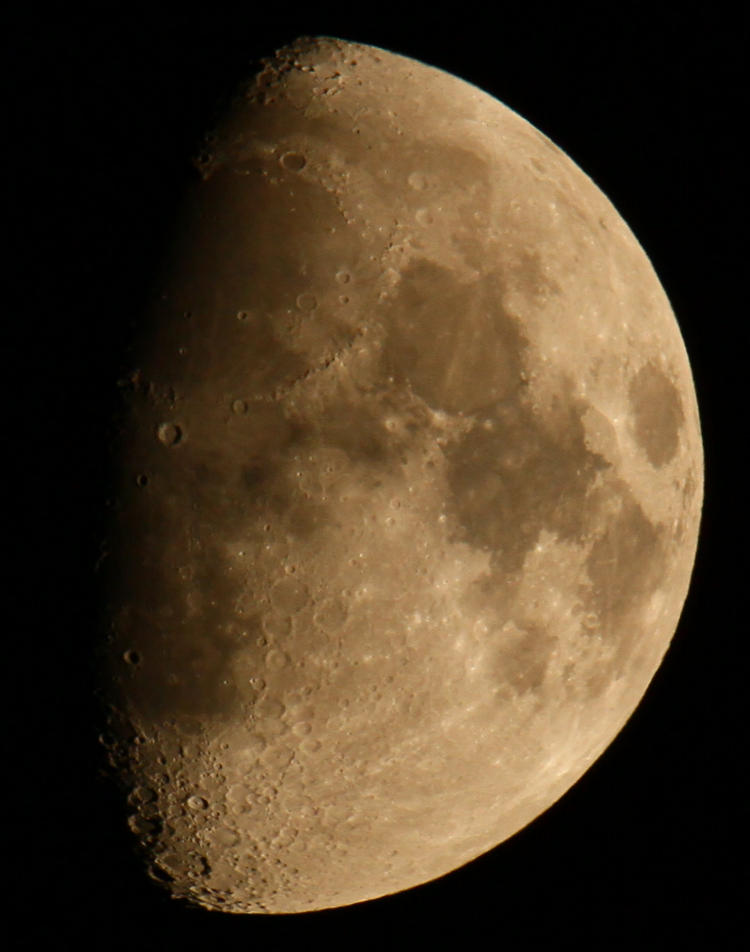Found a couple of subjects while poking around tonight, but only had very short periods of time to capture them, which I’ll explain in a moment. So this is what you get.
First off, I found that the spiny assassin (genus Sinea,) still occupying the basil plant, was polishing off a meal which looked a little odd, so I quickly went inside and got the reversed Sigma 28-105 and the flash unit. Oh, and the camera. We’ll start with a wider shot.

Reasonable detail from the body this time, and even the developing wings are visible, but this is still a nymph. It got its big ugly ogre-club foreleg in the way, but I was able to shift vantage a bit for a better look (largely accomplished by turning the pot and tipping it up onto a rock so I could sit on the ground for stability.) Before we go any further, we’ll go in closer on that head.

This is not quite full resolution, and required a bit of luck because I could not resolve this detail in the viewfinder to know when I had sharpest focus – this is one of several frames. Also, the batteries of the headlamp that I was using to focus were running down. I did some specific measurements this time: the overall length (proboscis to end of abdomen) of the assassin was just 9mm, and the visible portion of the head seen here is 2mm. Give or take ten percent – I couldn’t actually clamp a micrometer on it. You can see we’re at the limits of what the lens can do, some distortion already creeping in, but I snagged the facets of the eye, so I’m pleased enough with that.
Now we get a better look at its capture:

I’ll be honest, I thought on first look that it had captured a tiny snail, mostly because of how shiny the prey was, but I also couldn’t see the tucked legs until I achieved this angle. I recognized that big ‘nose’ (I believe it’s called the frons) and initially thought it might be a cicada nymph, getting excited for a moment because I’ve never seen one in the stage after hatching, before they burrowed underground for development, but then I recalled another species which I’d photographed many moons ago, and the shininess is pretty indicative. This is likely a spittlebug nymph, especially since I’d already seen the drippy evidence of them on the same plant earlier – if you’ve ever found clusters of foam on plants and wondered what it was, it was the protective traits of these guys, and that link above will provide plenty more views. There are at least three separate species that I’ve found in the area, which all belong to the Superfamily Cercopoidea, so that’s as much as I can offer right now.
At full resolution:

All that KY Jelly is its own product, mostly the sap that it draws from the plants, which it then pumps full of air bubbles and surrounds itself with for protection – it didn’t work in this case. You can’t see it here, but this little spud has its own proboscis like the assassin, only it uses it instead to suck out plant juices. And check out the little horseshoe-shaped spurs on the legs to clamp onto the plants.
Moving to the back yard now, I spotted some newly-drying wings peeking out from under the leaves of one of the Japanese maples, and then spent a frustrating couple of minutes trying for a decent photo as the headlamp got dimmer and dimmer. This is the best I managed:

This is a Carolina mantis (Stagmomantis carolina,) about half the size of the much more prevalent Chinese mantids, and the first I’ve seen in weeks. I didn’t even spot the molted exoskeleton at first, but the faintly translucent blue tint to the wings told me to look for it, because that only shows right after molting. This specimen was well aware that I was around and likely concerned about its exoskeleton being not fully hardened, and repeatedly danced around out of a clear view while I vied for a good position. Add in that I just had the Sigma lens which is for extreme closeup work and doesn’t provide as wide a view as the Mamiya, plus it’s fixed at f16 which was no help at all with the dimming light. It was fun (meaning, it involved a bit of cursing, but that’s not even uncommon with me.)
Coming back up the steps, I glanced up and saw the moon peeking through the clearing clouds. Mr Bugg is presently doing a long sequence of moon shots which you can only see if he’s friended you on FaceBlerck, since he’s abandoned his blog now – I don’t so social media. But he challenged me to get my own shots, which I’ve neglected up until it showed tonight through a small gap in the trees. Small gap – I knew it wouldn’t last long, what with the earth still spinning and all that, so I quickly got the long lens and tripod.

My position at the top of the steps was very limited, the moon moving rapidly (well, as moons go) behind the leaves. This was one of the initial frames without the teleconverter, and more than acceptably sharp, but I’d had to shift the tripod into a slightly unstable position to get it because the legs were already at the edge of the deck. After adding the teleconverter, I was already too late.

Without the preceding pic and a decent familiarity with the appearance of the moon, one might have missed how Maria Crisium, Fecunditatis, and Tranquilitatis got a bit darker, but it was just the leaves between the camera and the moon – my window was now closing. But hey, for a few minutes work (eighteen, to be exact, between the first and last images here,) I’m not complaining. Except about that uncooperative mantis…




















































